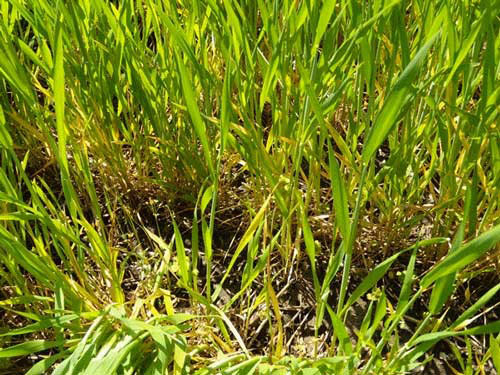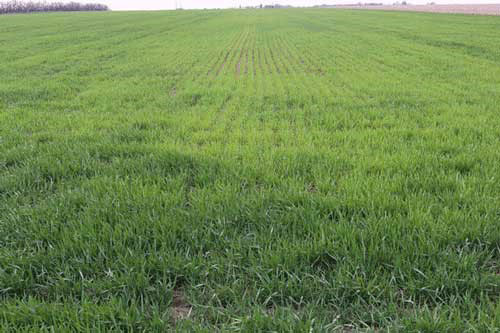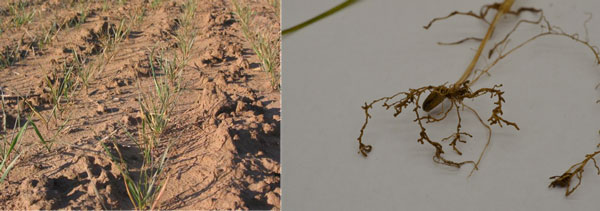Wheat producers may start seeing some wheat fields turn yellow during this time of the year. The pattern may vary from field to field, sometimes as large areas, small patches, or streaks of yellowish wheat in some fields this spring. What are some of the main causes related to nutrients and soil fertility for yellow wheat in the spring?
Nitrogen deficiency. As the crop starts to grow in the spring, its nitrogen (N) demand increases and it is common to see N deficiency, especially while the temperatures are lower and not much N is mineralized from the soil organic matter. Nitrogen deficiency causes an overall yellowing of the plant, with the lower leaves yellowing and dying from the leaf tips inward (Figure 1). Nitrogen deficiency also results in reduced tillering, top growth, and root growth. The primary causes of N deficiency are insufficient fertilizer rates, application problems, applying the nitrogen too late, leaching from heavy rains, denitrification from saturated soils, and the presence of heavy amounts of crop residue, which immobilize nitrogen.

Figure 1. Nitrogen deficiency on wheat. The lower leaves are the first to become chlorotic (yellow). Photo by Dorivar Ruiz Diaz, K-State Research and Extension.
Sulfur deficiency. Similar to nitrogen, the crop’s sulfur requirement increases in the spring as it takes off on reproductive growth. Due to a decrease in sulfur deposition in the rainfall, there has been an increasing number of fields with sulfur deficiency symptoms in Kansas in recent years. Deficiencies can be more common in areas where organic matter levels are low -- especially on sandier soils or eroded areas of a field. Sulfur deficiency can also occur where soils are cold in the spring due to a reduced rate of release of sulfur from organic matter. The symptoms of sulfur deficiency are very similar to nitrogen deficiency. However, sulfur deficiency differs from N deficiency in that the whole plant is pale, with a greater degree of chlorosis (yellowing of plant tissue) in the young/upper leaves (Figure 2). The pattern of chlorosis may show gradation in intensity with the younger leaves at the tip yellowing first because sulfur is not easily translocated within the plant. But the entire plant can quickly become totally chlorotic and take on a light yellow color. Symptoms often become more pronounced when plants begin growing rapidly while soil conditions are such that organic matter mineralization and sulfur release rates are low. Symptoms may disappear as the temperature warms up and moisture conditions improve, which increases the rate of mineralization of sulfur from organic matter and the rate of root growth.

Figure 2. Sulfur deficiency in wheat, with symptoms appearing first on the younger leaves. Photo by Romulo Lollato, K-State Research and Extension.
Low pH and poor root growth. Many potential causes exist for reduced root growth: dry soils and later sowing are common situations this year. Root damage due to aluminum toxicity in acidic soils can also result in multiple deficiency symptoms and poor growth (Figure 3). Strongly acidic soils may present several problems for wheat production. These include the combination of aluminum toxicity as well as deficiencies of phosphorus, calcium, magnesium, and molybdenum. These problems caused by acid soils are difficult to separate one from another and are often related to root damage due to Al toxicity. In general terms, aluminum toxicity will reduce the yield potential of wheat when soil pH levels get below 5.2 to 5.5 and KCl-extractable (free aluminum) levels are greater than 25 parts per million (ppm).
Typically, these symptoms become apparent in early spring and are exacerbated by drought such as this spring. Although the wheat crop may recover from this condition with sufficient moisture, the impact on yields may have already occurred. A corrective measure will require a lime application for the next crop.

Figure 3. Wheat growing on very acidic soils, such as this soil in Harper County with a pH of 4.6, is often spindly and has poor vigor. Photos by Dorivar Ruiz Diaz, K-State Research and Extension.
Dorivar Ruiz Diaz, Nutrient Management Specialist
ruizdiaz@ksu.edu
Romulo Lollato, Wheat and Forages Specialist
lollato@ksu.edu
Tags: yellow wheat nutrient deficiency soil pH soil fertility